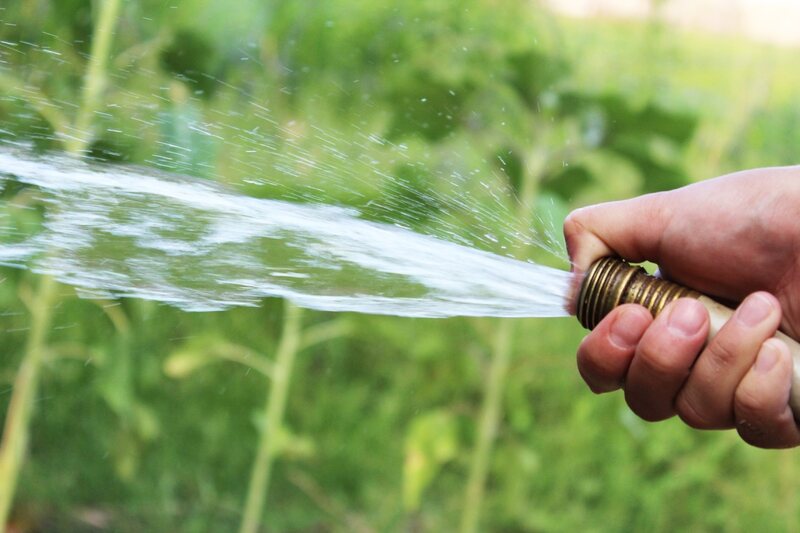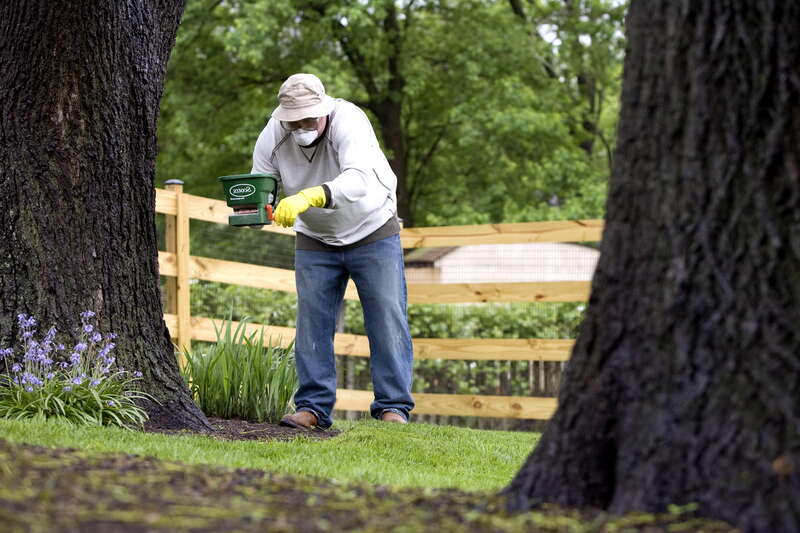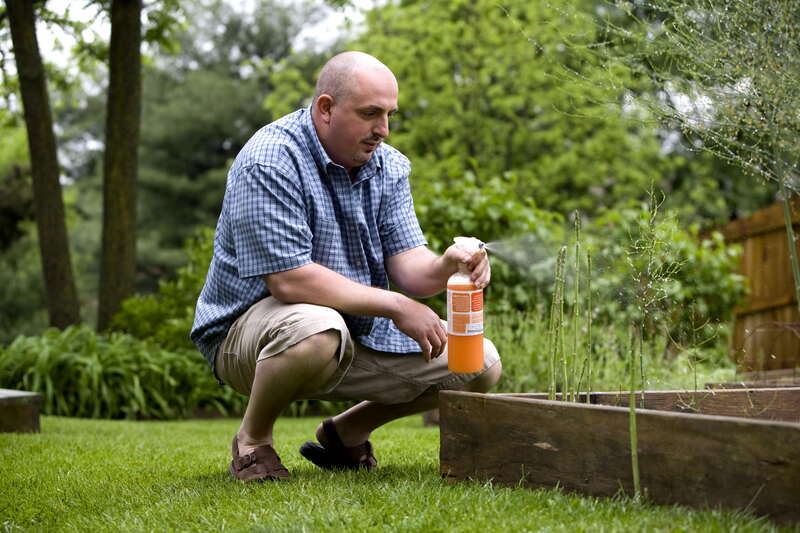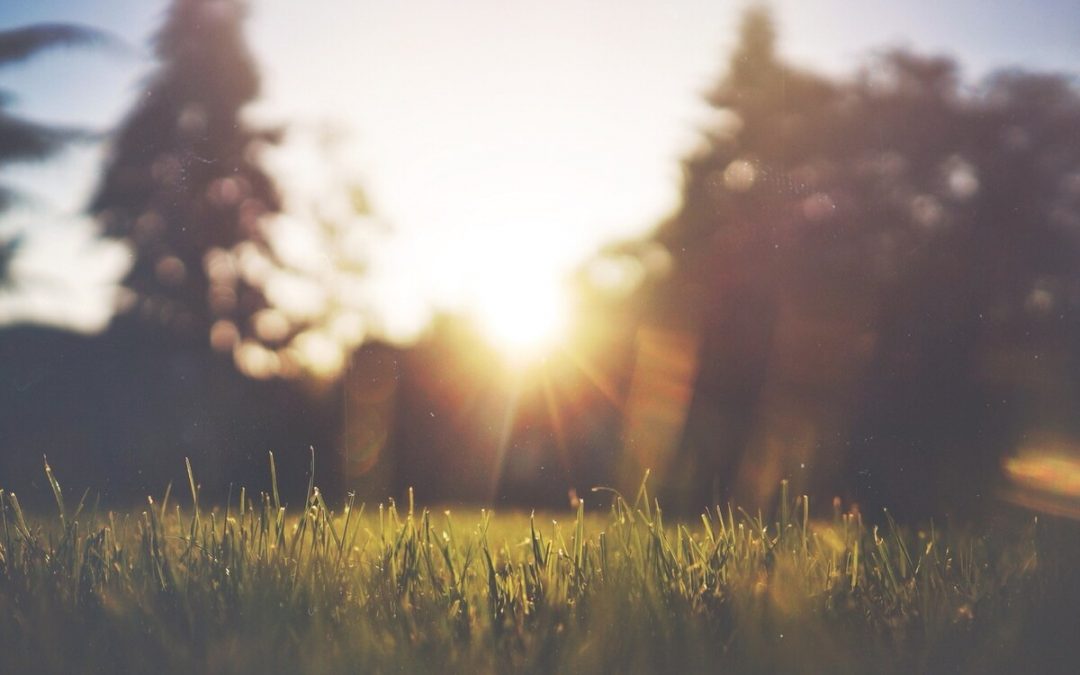Dallas averages 234 sunny days every year. Its subtropical climate and notoriously hot summers come with their own rulebook for lawn care. Nutrient-less and hard clay soils plague the Metroplex, making lawn preparations important if your plants are going to survive the North Texas sun. Follow this guide to summer lawn care in Dallas to give your lawn a fighting chance against the summer heat.
In this article, we’ll cover:
- Rise, Shine, and Water
- Mow More
- Limit Fertilizer
- Prep for Summer With Aeration
- Perform Pest Control
- Don’t Neglect Disease and Weed Control
What Makes Summer Lawn Care Important in Dallas?
Dallas is rainier than most Texas cities, averaging 40 inches annually. However, temps soar to 95 degrees Fahrenheit for most of the summer. These high temperatures and sunny days place a lot of stress on your Texas landscape.
May is the wettest month of the year, and spring months are ideal for your plants and grass to establish healthy roots to help them survive the tough summer.
Summer is the most demanding and damaging time for your lawn. The excessive heat, potential drought conditions, and Dallas water restrictions can lead to a brown and stressed lawn, making proper lawn maintenance from June to September vital.
6 Tips for Summer Lawn Care in Dallas
1. Rise, Shine, and Water

Photo Credit: Pxhere
How you water and how often you water are equally important to your Texas landscape. Your Dallas native plants and turfgrass are adapted to withstand Dallas’ USDA hardiness zone 8, including heat and potential drought.
Follow Dallas’ ordinances and these watering tips to keep your landscape in the best shape throughout the summer:
- Water on designated days determined by your address
- Make sure your lawn gets 1-2 inches of water per week (including rainfall)
- Soak your lawn once or twice a week in place of short daily watering
- Water 4 to 6 inches deep into the soil to help plants and grass develop deep, drought-resistant roots
- Water early in the morning to minimize fungal growth and evaporation
It’s important to note that an irrigation system with directed sprinkler heads removes the guesswork from determining how much water your lawn needs. You can program your system to apply the right amount of water for your grass type, saving you time and money while increasing the health of your lawn.
Bermudagrass
Bermudagrass thrives in the dense clay North Texas soils. This popular turfgrass stands up to frequent foot traffic and loves full sun. Bermudagrass requires one to 1.25 inches of water per week.
Water your bermudagrass twice per week early in the morning before 9 a.m. Aim for 15 minutes of watering per zone for automatic pop-up head sprinklers and 35-minute sessions for rotary heads.
St. Augustinegrass
St. Augustinegrass appears to be the exact opposite of aggressive bermudagrass, but these warm-season grasses thrive in Dallas. St. Augustinegrass does not tolerate foot traffic and prefers partial sun or shade. The fast-growing grass requires only 1 inch of water per week, making it an economical choice for your lawn.
Water St. Augustinegrass twice per week before 9 a.m. Water each zone for 15 minutes for pop-up head sprinklers, and 30 minutes for rotary heads.
Zoysiagrass
Zoysiagrass handles anything you throw at it: drought, traffic, shade, and even low temperatures. The dark green turfgrass requires little fertilization, and its dense blades block out weeds. Like St. Augustinegrass, it only requires 1 inch of water per week.
Water your Zoysiagrass lawn twice per week before 9 a.m. Aim for 15-minute sessions if you are using pop-up head sprinklers, and 30-minute sessions for rotary heads.
Buffalograss
Native buffalograss grows well in the nutrientless clay soils, requiring little fertilization. However, the low-fuss grass does not stand up to heavy foot traffic or weeds. Like Zoysia and St. Augustine, this cultivar requires 1 inch of water per week.
Water your buffalograss before 9 a.m., twice per week. Aim for 15-minute sessions if you are using pop-up head sprinklers, and 30-minute sessions for rotary heads.
Centipedegrass
Centipedegrass does not handle traffic or herbicides. However, it is incredibly low-maintenance with low mowing and watering requirements. This smooth, flat-bladed turfgrass requires one to 1.25 inches of water per week to remain green.
Water centipedegrass twice per week before 9 a.m. If you are using pop-up head sprinklers, aim for 15-minute sessions. However, if you are using rotary heads, be sure to extend your sessions to 35 minutes.
2. Mow More
We all want to be in the pool or inside in the air conditioning, and it is really tempting to mow our lawns short to make less work for ourselves. However, cutting your grass short leaves it vulnerable to weeds, scorching, and dormancy.
Your grass should never change from green to brown after mowing. Brown grass signals a stressed lawn, meaning you have removed too much at one time. Be sure to raise your mower height after your lawn has recovered before your next mow.
Taller grass blades develop deeper roots and provide shade, cooling the soil underneath and minimizing evaporation, which makes your morning watering sessions more efficient. Your lawn will be lusher and stay greener, increasing your home’s curb appeal.
Follow these summer mowing tips for your warm-season grass:
- Sharpen mower blades frequently
- Mow regularly, keeping grass 2-3 inches tall
- Mow less than ⅓ of your grass’ length to reduce trauma
- Leave grass clippings on the ground to use as mulch
Bermudagrass
The recommended mowing height for bermudagrass is 1-2 inches using a traditional mower. During active growing seasons in the spring and early summer, plan to mow your lawn weekly, never cutting more than ⅓ of your grass’ total length.
St. Augustinegrass
St. Augustinegrass prefers higher heights in the summer to help water retention. You should mow your St. Augustine lawn every seven to 10 days, aiming for a mowing height of 2.5 inches.
Zoysiagrass
Zoysiagrass actively grows in the summer, requiring regular mowing every five to seven days. Like bermudagrass, never cut more than ⅓ of your grass’ total length and aim to keep your lawn between one to two inches high.
Buffalograss
Buffalograss prefers higher heights like St. Augustinegrass. You should aim for a height between two to three inches, requiring a mowing session every seven to ten days.
Centipedegrass
Centipedegrass is another turfgrass, preferring taller heights. Mow weekly with a traditional lawn mower, keeping your grass between 1.5 to two inches high.
3. Limit Fertilizer

Photo Credit: Pixnio
Fertilizer promotes healthy growth, but be careful, too much of a good thing can harm your landscape. Unseasonably hot and dry Texas summers can lead to dormant grass. It is tempting to over-fertilize your lawn. Unfortunately, this will have the opposite effect and harm your turfgrass by burning it.
Here are some summer fertilizing tips for your Dallas lawn:
- Select a summer nitrogen-based fertilizer designed for your grass type
- Irrigate fertilizer applications to help nutrients enter the soil
- Never fertilize dormant grass
Bermudagrass
Bermudagrass thrives with regular fertilizer applications. During the summer, this turfgrass requires 0.5 to one pound of nitrogen per 1,000 square feet every month. You should aim to apply 2 to 6 pounds of nitrogen per 1,000 square feet annually to keep your lawn healthy.
St. Augustinegrass
St. Augustinegrass has higher fertilization requirements, like bermudagrass. Apply 2 to 4 pounds of nitrogen per 1,000 square feet of lawn annually, or 0.5 to one pound of nitrogen per 1,000 square feet monthly during the summer growing season.
Zoysiagrass
Zoysiagrass has the similar requirements to bermudagrass. During the summer growing season, apply 0.5 to one pound of nitrogen per 1,000 square feet of lawn monthly for a total of 1 to 3 pounds of nitrogen per 1,000 square feet annually.
Buffalograss
Buffalograss has incredibly low fertilization requirements. In fact, some homeowners skip applications completely. Typically, buffalograss up to 2 pounds of nitrogen per 1,000 square feet of lawn annually. Aim to apply 0.5 to 1 pound of nitrogen per 1,000 square feet during two months of the active summer growing season.
Centipedegrass
Low-maintenance centipede grass requires little fertilization. Aim for 1 pound of nitrogen-based fertilizer per 1,000 square feet applied twice, once in June and again in September.
4. Prep for Summer With Aeration
Texas is one of the few places in the U.S. with clay soil. Unlike the loose, sandy soils of the Southeast, impacted and dense clay soils require biannual lawn aeration. Liquid aeration helps your lawn handle the intense heat and dry conditions of summer by opening pathways for air, sunshine, water, and nutrients to penetrate the soil, resulting in deeper, more drought-resistant roots.
Warm-season grasses like bermudagrass, Zoysiagrass, and St. Augustinegrass, require liquid aeration applications in late spring before summer and early fall.
5. Perform Pest Control

Photo Credit: Pixnio
Plenty of pests hide from the heat of the Texas sun, seeking shaded areas under decks and logs. Unfortunately, white grubs, chinch bugs, and fire ants are notoriously sun-loving Dallas pests that can wreak havoc on your warm-season turfgrass.
Keep these pest control tips in mind this summer:
- Watch for yellow or brown patches resembling drought stress. This could be a sign of chinch bugs or white grubs infestations, especially in St. Augustinegrass.
- Keep an eye out for sandy fire ant mounds popping up in your yard.
- Treat fire ants with granulated pesticides.
- Spot-treat areas affected by chinch bugs or white grubs with a targeted non-repellent insecticide.
- Irrigate areas affected by white grubs after pesticide application.
Bermudagrass
Bermudagrass is the most popular turfgrass choice for Texas lawns. Unfortunately, it has a low resistance to unfriendly visitors. It is prone to white grubs, hunting billbugs, mole crickets, army worms, and sod webworms.
Regular lawn maintenance and irrigation help combat pest infestations. Additionally, spray a non-repellent broad-spectrum insecticide over infected areas to combat pests.
St. Augustinegrass
St. Augustinegrass is fast-growing and shade-loving. It also attracts many pests, including chinch bugs, cutworms, mole crickets, grass loopers, army worms, web worms, and grubs.
Combat pests ruining your lush lawn by using a non-repellent broad-spectrum insecticide. Be sure to look for one containing carbaryl, trichlorfon, or pyrethroid if you are dealing with chinch bugs or grubs.
Zoysiagrass
Zoysiagrass stands up to most pests thanks to its thick leaf blades and dense structure. Occasionally, mites, grubs, mole crickets, hunting billbugs, army worms, chinch bugs, or sod webworms will move in and set up residence in your lawn.
Always wait until your grass has greened in the spring or early summer to apply insecticides. Use spot treatments of broad-spectrum pesticides as needed to combat insect infestations.
Buffalograss
Native buffalograss resists most pests. However, mealybugs, buffalograss webworms, mites, short-tailed crickets, and chinch bugs can cause the occasional headache.
Spot treat affected areas with broad-spectrum repellent-free pesticide.
Centipedegrass
Centipedegrass is low-maintenance and prefers to be left alone. It is moderately prone to pests, including ground pearl insects, grubs, mole crickets, sod webworms, and lawn caterpillars.
Irrigate and mow your lawn 24 hours before insecticide applications. Treat affected areas with a broad-spectrum non-repellent insecticide containing carbaryl or pyrethroid. Aim to apply preventative treatments in May before the heat of summer sets in and follow-up with another application in June.
6. Don’t Neglect Disease and Weed Control
Turfgrass diseases and weeds love a weak lawn and signify an underlying problem with your lawn’s health. They love low-nitrogen soils, imbalanced pH, and thinning turf. Weeds steal vital nutrients, water, and sunlight from your turfgrass and plants while simultaneously spreading pests and diseases.
Maintain a healthy lawn with routine maintenance, watering, and fertilization schedules, and weeds and diseases won’t stand a chance. There are two ways to control weeds in your lawn: chemical treatments and hand pulling. Pulling weeds by hand is the safest removal method, but it isn’t always the best method. Be sure to identify the type of weed you are dealing with before selecting your removal method.
Follow these summer weeding tips to maintain a healthy lawn:
- Always use targeted post-emergent herbicides to eliminate weeds before they bloom.
- Spray herbicides sparingly to avoid scorching your grass.
- Consider hand-pulling weeds or using a dandelion fork to remove broadleaf weeds with taproots.
- When in doubt, pull your weeds by hand in place of chemical treatments.
Bermudagrass
One of the star attributes that makes bermudagrass so popular in North Texas is its disease-resistance. If you are unlucky enough to experience a disease infestation with your bermudagrass, chances are good it is spring dead spot, dollar spot, leaf spot, large patch, or sheath spot.
Combat bermudagrass weeds and diseases using a pre-emergent herbicide in the spring when soil temperatures reach 55 degrees Fahrenheit. If you notice brown patches with regular and smooth outlines caused by fungal diseases, treat your entire lawn with a fungicide designed for bermudagrass.
St. Augustinegrass
For all its strengths, St. Augustinegrass falls short in the disease-resistance category. It is moderately to highly prone to diseases such as gray leaf spot, large patch, and take-all root rot.
Combat fungal diseases in your St. Augustine lawn with an indoor-outdoor fungicide and disinfectant designed for plants.
Zoysiagrass
Zoysiagrass is incredibly resistant to most diseases. However, large patch, root decline, spring dead spot, rust, curvularia, and leaf spot can occur.
Like St. Augustinegrass, fungal diseases are the most common. Treat your lawn with a preventative fungicide program. Apply fungicide in the spring to decrease your chances of developing diseases like large patch. If you notice dead spots in your lawn and have ruled out insect activity, treat the affected area with an indoor-outdoor fungicide and disinfectant for plants.
Buffalograss
Thanks to its adaptability, buffalograss has high disease-resistance. Treat the most common problem, bipolaris leaf spot, with preventative fungicide at the first sign of brown patches.
Centipedegrass
Centipedegrass is moderately disease-tolerant. It is prone to centipedegrass decline and iron chlorosis. Combat these lawn diseases with proper lawn maintenance and apply 2 ounces of iron sulfate per 1,000 square feet if you notice yellowing.
FAQ About Summer Lawn Care in Dallas
Succulents thrive in the Dallas-Fort Worth area. Typically, water your succulent plants once per week when it has not rained.
Organic mulch provides moisture retention and nutrients for your plants. Experts recommend laying new mulch on top of your existing mulch annually in the spring after the last frost.
Dallas adopted lawn and landscape irrigation ordinances in 2012 to defer the costs of expanding the city’s water supply infrastructure. Drip irrigation, hand watering, and soaker hoses are allowed at any time and on any day.
However, Dallas homeowners can only water with hose-end sprinklers or automatic sprinkler systems twice per week from April 1 to Oct. 31. No watering may take place between 10 a.m. to 6 p.m. or on Mondays, Tuesdays, or Fridays.
Professional Dallas Summer Landscape Maintenance
Summer is the perfect time for lazy days. The days are sunny and long, and backyard barbecues and pool parties are in full swing. Reclaim your weekends and sanity by installing low-maintenance landscaping and following our summer lawn care tips.
Instead of breaking a sweat in the heat, consider letting Wikilawn hook you up with a local landscaping company that can handle all of your lawn care needs so you can get back to your Longhorns or Aggies.
Main Image Credit: Pxhere

